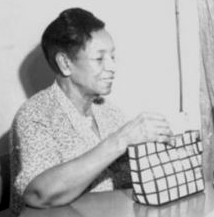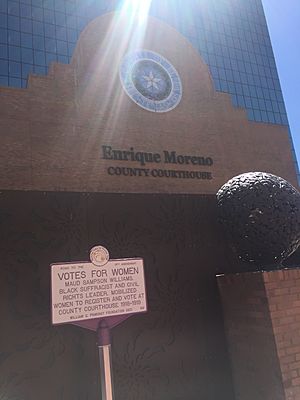Maud E. Craig Sampson Williams facts for kids
Quick facts for kids
Maud E. Craig Sampson Williams
|
|
|---|---|

Williams at a state NAACP meeting in Dallas, June 1954
|
|
| Born | February 1880 Texas, US
|
| Died | March 13, 1958 (aged 78) Oklahoma City, Oklahoma, US
|
| Burial place | Austin, Texas |
| Known for |
|
Maud E. Craig Sampson Williams (born February 1880 – died March 13, 1958) was an important American leader. She was a teacher, a champion for civil rights, and a community activist in El Paso, Texas. Maud Williams worked hard to help women gain the right to vote. In 1918, she started the El Paso Negro Woman's Civic and Equal Franchise League. This group helped African-American women register and vote in Texas. She also helped create the El Paso chapter of the NAACP, which was the first one in Texas. Williams played a big part in ending segregation at Texas Western College in 1955. This college was the first undergraduate university in Texas to allow students of all races.
Contents
Early Life and Teaching Career
Maud E. Craig was born in Texas in 1880. She grew up in Central East Austin, a historic African-American neighborhood. Her father, George W. Craig, was a grocer. Her mother was Maine Craig. Maud was the oldest of five children.
In 1900, Williams graduated from Prairie View State Normal and Industrial College. This school is now known as Prairie View A&M University. She was seen as a "New Negro Woman" of her time. This meant she valued education and professional success.
In 1904, Williams moved to El Paso to teach at Douglass School. This was the only school for African-American students in the city. She helped start the Parents' Organization at Douglass School. Later, she returned to Austin and taught at Gregorytown School. In 1906, she helped found the Douglass Club of Austin. Many members of this club were also African-American teachers.
Williams later came back to El Paso. On June 8, 1907, she married Edward D. Sampson. He was a barber and later worked for the city of El Paso.
Working for Women's Right to Vote
Maud Williams was very active in the women's suffrage movement in El Paso during 1918 and 1919. Suffrage means the right to vote. In early 1918, her African-American women's club supported a white suffrage leader named Belle Critchett. Williams also spoke publicly about why women should be able to vote. For example, she gave a speech about women's suffrage at the Juneteenth celebration in El Paso in June 1918.
In March 1918, Texas passed a law allowing women to vote in primary elections. This was the first time women in Texas could vote. After this, women in El Paso began to get ready to register for the July Democratic primary election.
Williams led the Phyllis Wheatley Club, which discussed women's suffrage in May 1918. They planned to create an organization for Black women who wanted to vote. On June 12, 1918, Williams held a meeting at her home. Fourteen African-American women and nine white women from the El Paso Equal Franchise League attended. They talked about forming a group to help Black women vote.
That evening, the African-American community met and formed the El Paso Negro Woman's Civic and Equal Franchise League. Williams was chosen as its president. This group helped women register to vote. Many of these women had sons serving in World War I. This showed that Black women wanted the right to vote to help their entire community.
In June 1918, Williams asked the National American Woman Suffrage Association (NAWSA) if her group could join. NAWSA sent her request to the Texas Equal Suffrage Association (TESA). However, TESA leaders did not want to admit African-American suffragists. They worried it would upset white men and stop women from getting the right to vote nationally.
Despite being turned down, Williams and her league kept working. Just two days after their group was formed, they met to discuss registering for the July 27, 1918, Democratic primary. This was the first time women in Texas could vote.
On June 21, Williams's league held a meeting and registration rally. Speakers talked to African-American citizens about the candidates. Williams also led efforts to register African-American women. Many Black women registered on the first day. In some areas, African-American women were the first women to register.
Williams continued her political work after the 1918 election. In 1919, she helped with a statewide vote on women's suffrage. In 1920, she helped Robert E. Thomason, who was running for the Texas House of Representatives. Thomason won and became the Speaker of the House.
Community and Civil Rights Work
Maud Williams did much more than just work for voting rights. She was known for her many contributions to the community. She pushed for public housing and places for African-Americans to relax and play in El Paso.
Williams helped start the Phyllis Wheatley Club in El Paso in 1914. This club aimed to promote happiness and friendship among women. It also supported good causes. In 1919, the Phyllis Wheatley Club helped create Memorial Park to honor El Pasoans who served in World War I. The club also organized a parade and picnic for African-American soldiers returning from the war.
In May 1919, Williams asked the El Paso city council for a tennis court for African-American children. She explained that her club had set up a playground. She said recreational places were needed because local movie theaters did not allow African-Americans. The city council agreed to install the tennis court. Williams told them the club had a clubhouse with activities like storytelling and music lessons for children.
Fighting for Civil Rights
From 1917 to 1924, Williams was the vice president of the El Paso chapter of the NAACP. This chapter was the first one in Texas, started in 1914. Williams stayed active in the NAACP throughout her life. The NAACP worked to challenge the "white primary" laws, which stopped African-Americans from voting in primary elections. These laws were finally declared unconstitutional in 1944.
In the 1950s, Williams led the Legal Redress Committee of the El Paso NAACP. In September 1954, after the Brown vs. Board of Education Supreme Court decision, Williams's committee tried to desegregate Texas Western College. Williams went with Thelma Joyce White, a top student from Douglass School, to register her for classes. White was denied admission.
This led to a court case called White vs. Smith in 1955. Future Supreme Court justice Thurgood Marshall represented White and the NAACP. The court ruled that Texas Western College had to allow students of all races. The judge in this case was Robert E. Thomason, the same person Williams had helped elect in 1920. Texas Western College, now the University of Texas at El Paso, was the first college in Texas to desegregate its undergraduate programs. This decision helped end segregation in higher education across the state.
Later Life and Legacy
Maud's first husband, Edward Sampson, died in 1926. In 1929, she married Emerson Milton Williams, a dentist. Emerson Williams died in 1947. In June 1957, Maud Williams moved to Oklahoma City. She died there on March 13, 1958, in a traffic accident.
Even today, the Douglass Club of Austin and the Phyllis Wheatley Club of El Paso are active groups of African-American women.
A scholarship fund was created at the University of Texas at El Paso in 1968. It honors the achievements of civil rights leaders like Maud Sampson Williams, Dr. Lawrence A. Nixon, and Le Roy W. Washington.
Texas Western College (now UTEP) continued to be a leader in the civil rights movement in Texas. It was the first undergraduate school in Texas to admit African-Americans. It was also the first to hire Black teachers and allow Black athletes to play. In 1966, the Texas Western basketball team, led by coach Don Haskins, won the NCAA national championship. They were the first college basketball team to start an all-Black team in the national championship game. That same year, Marjorie Lawson became the first African-American teacher in the University of Texas system at Texas Western College.


